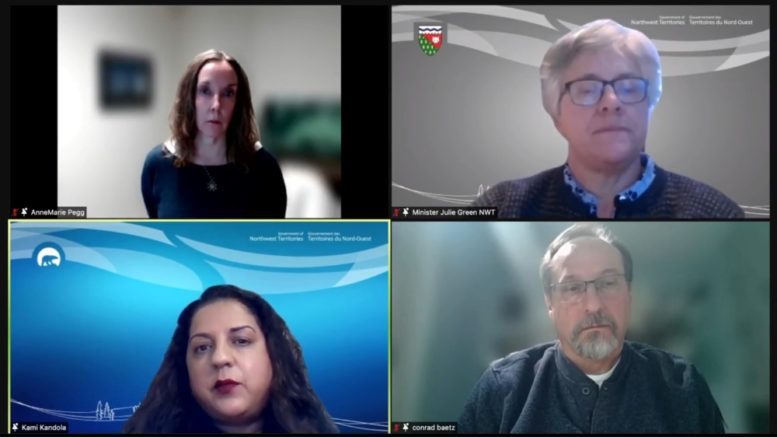While the health care system has a big role to play, it’s up to NWT residents to stop the spread of COVID-19.
That was the message from health officials during a news conference Wednesday afternoon.
“There’s something that we need to be pretty clear on. That is that the healthcare system in itself can’t handle the Omicron wave,” said Dr. AnneMarie Pegg, the territorial medical director. “We are a small piece. And quite honestly, we’re often the end piece, we are the system that is looking at dealing with the people who become very sick… But what needs to happen in order to handle the Omicron wave is there needs to be less cases, and the only way that there can be less cases is if people reduce their contact, make sure they’re wearing a mask, get vaccinated and follow the public health measures.”
Earlier in the news conference, Pegg explained that while the omicron variant is milder on an individual level — people are most likely to recover safely at home — the sheer number of cases is putting a strain on the territory’s health care system.
So far, public health has only reported one hospitalization in the nearly-1,200 active cases of COVID across the NWT.
But Dr. Kami Kandola, the chief public health officer, said that number is likely going to change as this ongoing wave peaks in the coming weeks.
“I know Omicron is spreading pretty quickly,” said Kandola. “This is the first time we’ve ever had over 1000 active cases. But we’re not being fatalistic. The intent is that we are going to slow the spread as much as we can and that at some point, we will peak and cases will start to decline.”
Living with COVID means tradeoffs: Kandola
Both Pegg and Kandola reiterated many times the need for residents to get vaccinated (including boosters), to maintain masking and distance to slow the spread of the virus — the same messaging for the past year.
The vaccination rate stands at 77 per cent for the eligible population five years old and up. Kandola said only 53 per cent of children between 5 and 11 years old have gotten their first dose of the vaccine.
She said public health has health promotion teams trying to increase the vaccination rate for that age group.
She also said only 42 per cent of those eligible for a booster dose have gotten it.
CKLB asked Kandola if she thought the messaging was working if case numbers continue to grow and the territory’s health care system is already overwhelmed.
“One of the ways we’re trying to live with COVID is we do tradeoffs,” she said.
Kandola explained holiday travel as one of the trade offs the territory made: allowing travel to see friends and family meant accepting a significant rise in case numbers as people returned. Kandola said 8,600 residents travelled over a 21-day period.
As part of the tradeoff, she added, public health provided test kits upon return (although that didn’t happen for several days in the new year after they ran out), and asked residents to limit their contacts for the first three days they returned.
“This is directly a partnership,” said Kandola. “At one point, the public health order will be lifted, but we’re in this grey area right now, where we have a variant that can transmit pretty quickly and we require everyone vaccinated or not to follow the healthy habits and the practices that we’re talking about.”
She later added: “Across Canada, if you’re looking at ICU numbers on hospitalization, it is still the unvaccinated that are driving that significant increase.”
Despite that being the case, Kandola and Julie Green, minister of health and social services, said they were not prepared to introduce any penalties for people that are not vaccinated.





